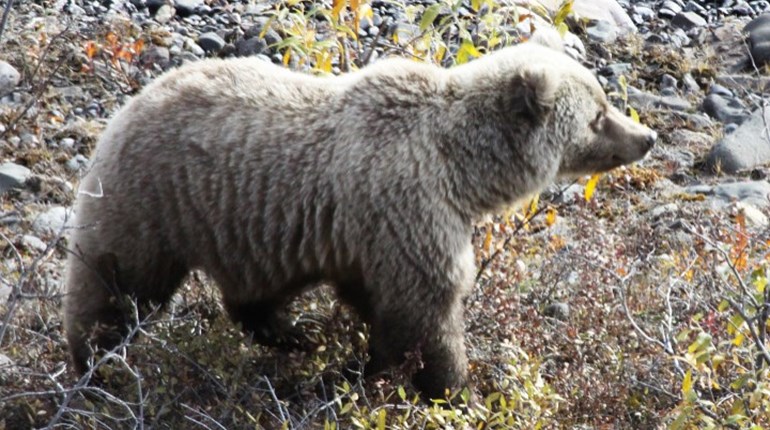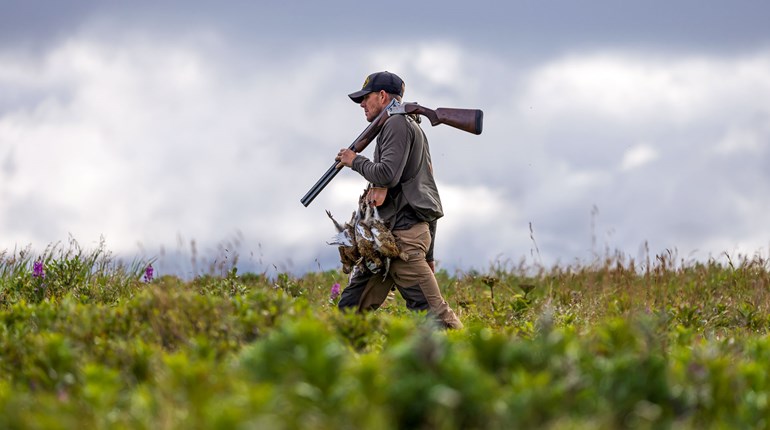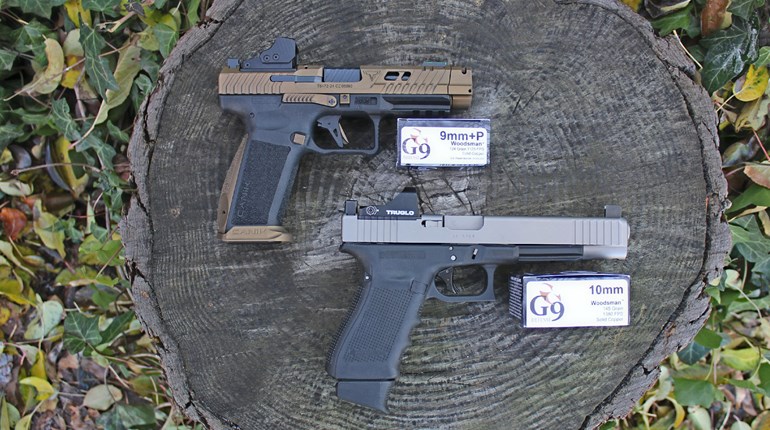
On a gray Sitka day, a friend jogged down a steep, zigzag stretch of Harbor Mountain Trail. He exited a dense patch of subalpine dwarf hemlock onto a scree slope, looked up and saw a brown bear charging downhill. He yelled as he drew his Glock 10mm loaded with Underwood hard-cast bullets. When the bear kept coming, he shot into the rocks about 5 yards ahead. It “turned inside out with a startled expression,” swerved aside and crashed past at 20 yards. At 150 yards it paused to look back. He figured this was a case of mistaken identity.
Jim shot a dandy Mulchatna bull caribou near dawn. He and Hugh boned it out, loaded their packs and headed for camp. A big Alaska Peninsula brown bear stood on its hind legs in a willow patch, smelled the meat and began trailing them, 30 yards back. The bear stopped when they did, and ignored Jim’s warning shot. Hugh did not want the bear following them back to camp, and suggested they charge their pursuer. He’s also a pretty good salesman. They shed their heavy packs, checked their rifles and ran at the massive bruin, screaming like maniacs. “That bear just about did a back flip getting out of there … we never saw it again.” That had to be the strangest act of extreme aggression the bear had ever seen.

Biologists also act aggressively when hazing nuisance bears. In bear confrontations, signaling confidence is important.
I blew a deer call near the base of a forested ridge and glimpsed something moving down a draw toward me. When a brown bear popped out of the brush 20 yards away, I stood, pushed the safety off and began explaining in a firm, even voice why the Bears were a second-rate football team. My wife is a Packers’ shareholder so I had lots to say. The adult brownie froze when I started talking, and looked and listened intently. Eventually it heard enough, turned and left.
■ ■ ■
I’m a retired Alaska Department of Fish & Game biologist, fascinated by bears and how they interact with humans. I was raised in Alaska, studied black bears for my master’s thesis and taught firearm, hunter and bear-safety courses.
Over the years I’ve listened to the debate about what to do when encountering a bear in the backcountry. In some cases, I have personally participated in the collection of real-time data, albeit unexpectedly. Some have had success talking to a bear, or talking it out of charging or doing harm. Some carry pepper spray or other less-than-lethal means of defense. Some carry firearms. Some figure they’ll use a firearm to fire a warning shot before they fire a shot to kill. In Alaska, you may kill a brown or black bear in defense of life or property (DLP).
Of course, a warning shot may or may not work. The effects of one take time to play out—time a person alone in the backcountry may not have during an encounter. Often, there is never complete knowledge of whether the bear means harm. Mainly, warning shots carry no guarantees, but an armed partner is good insurance.
Shots that pass near a bear’s head or kick up gravel or rock splinters work best, but may injure the bear. Killing a bear in DLP means skinning it and hauling its skull and hide to ADF&G, filling out a form and legally defending your actions. Polar bears are federally managed under more stringent rules. Shots without ear protection can cause hearing loss. Warning shots use up cartridges. Big bolt rifles are effective but take time to reload and carry fewer rounds than a semi-automatic 10mm with a 15-round magazine. Most people lower their rifles to work the bolt, and many bear attacks feature stress-related firearm operator errors.
Guides are comfortable with bears and big thumper rifles, and quietly sneak in and out of their hunting areas. Most guides watch, wait and sometimes talk to obstreperous bears, certain they will back off if handled correctly. In the rare event that a bear passes their limits, they’ll drop it.
Hikers, joggers and mountain bikers often carry bear spray or pistols.
Handguns are on the low end of firearm performance in terms of accuracy and effect. Pistols can kill bears, but come with a higher risk of failure. I generally pack a ported .460 S&W Mag. filled with quality handloads when hiking solo with my dog, or a .416 Taylor when responsible for others. That 5-pound pistol would really ring my chimes, but carries well in a flapped holster on a belt supported by carpenter’s suspenders. Trade-offs!
■ ■ ■
This article is based on 41 detailed interviews, about that many partials (informally collected, less-detailed stories) and personal experience. I put together a page-and-a-half questionnaire for the interviews. Although this is a pile of stories, it is a small scientific sample given the complicated variables involved. Ultimately, of course, deterrent outcomes depend on the bear, unless the potential victim switches to lethal firearm mode. The biggest challenge was collecting accurate, complete information, which often meant follow-up questions after reviewing my notes. I enjoyed collecting the old timers’ bear stories.
I live in Sitka, so many stories involve rainforest brown bears. Coastal brownies are well fed and behave differently than black, polar or north-slope grizzly bears.
Polar bears live far from Alaska’s forests in a world of ocean ice.
John was watching an open lead for migrating bowhead whales when a sub-adult polar bear approached. He fired a 12-gauge warning shot and it turned away. Last spring, whale watchers experienced about two dozen encounters with curious/testing polar bears that responded well to warning shots or cracker shells.
“Of course, a warning shot may or may not work. … Often, there is never complete knowledge of whether the bear means harm.”
A friend had three run-ins with barren ground grizzlies near Kotzebue that charged as soon as they saw him, circled downwind, smelled him and left. He fired unheeded warning shots near the first two. He figured they wanted to know if he was food or foe.
Ported revolvers and magnum rifles at close range produce the most decibels.
A Sitka hunter had a misadventure involving a deer call, a brown bear that objected to his shout, a switch between rifle and camera and back again, and high stress problems with rifle mechanics. The bear was shaking him by his left knee when he finally brought his .300 Win. Mag. into play. He didn’t want to shoot himself in the foot, so he held the rifle vertically with his thumb on the trigger and muzzle outside the bear’s head. He torched off a round. The bear chomped down hard, then sat back with a “thump,” eyes spinning like a kids’ cartoon. The hunter recovered his rifle and jacked another cartridge as the shell-shocked bear stumbled off into the pucker-brush.

At Kalinin Bay, a brownie charged down a steep forested slope toward a family hiking group pinned along the high tide shore. Don stepped forward and hosed it with bear spray. He kept spraying the bear's face as it sneezed, shook its head and postured 10 feet away. Don emptied the can and the bear slowly walked back uphill. When it launched another “full-on charge,” a warning shot from Don's .44 Mag. turned it, and that stubbornly aggressive bear finally decided to leave.
My personal closest was a revolver shot over the head of a juvenile delinquent brown bear 10-12 feet away. It jumped back, gave me a hurt look and left at a walk.
At least two charging brown bears intended serious harm.
A couple arrived on the brushy bank of a salmon stream near a mother bear with cubs. The sow shied away at first then turned and charged full tilt. When Don shot into the water, she sprinted through the water spout like it wasn’t there. His second shot brained her at less than 10 feet with a hard-cast, heavy .44 Mag. bullet; the high-speed splashdown drenched the couple. For weeks they relived the life-threatening experience in slow motion and Technicolor. Ultimately, they decided two guns were better than one and they wanted their hands free. Don now packs a .460 S&W Mag.; Denise has the .44 Mag. and shoots it very well.

The other close shave involved a bear guide and his assistant escorting three chum salmon researchers on a narrow trail along a steep gorge. A brownie sent her cubs up a tree and bluff charged, woofing as she came. She returned to the tree and looked up, then pivoted and charged with silent intensity. About 10-15 yards from contact, a shot from a .375 H&H Mag. near her head made her veer off the trail. She eventually woofed from dense cover and the cubs scrambled down to join her. She brushed noses with the first then led them downhill and away. In another trail encounter, a passive-aggressive bear claimed a narrow spot, ignored shouts and a warning shot, and made two hikers go around.
Kodiak has long had a reputation for bears coming to the dinner-bell sound of a rifle shot.
A friend was gutting a Kodiak deer when he noticed magpies flying from alder to alder towards him. When an adult brownie stepped out, he fired a shot from his .338 Win. Mag. between its feet. The bear stared hard as he backed away, then claimed the carcass. In Alaska you can legally kill a bear in defense of life and property, but harvested game is excluded. Bears are highly intelligent animals, focused on food; a fat deer carcass rewards aggressive behavior and prompts repetition. Riding the ferry after a successful Kodiak deer hunt, I talked to four Anchorage bowhunters who said they lost two arrowed deer to bears that appeared soon after the kill. The hunters believed, like others, the bears were shadowing them. Big bears can make Alaska deer hunting a defensive-minded exercise.
I have half a dozen stories of alpine deer and mountain goat hunters pushed by brown bears.
After the hunters shot their game, bears approached before they could process the meat. Some required multiple shots into nearby rocks before they would back off and wait. When hunters left with full packs, the bears moved in quickly. A friend described a goat he shot on a grassy side slope so steep they had to tie it to a bush before butchering. He looked back uphill at about 60 yards to see a brownie pop out of a nearby brush patch and approach the remains. That bear waited while they worked on the meat, close enough to be on them in seconds. They appreciated its patience.
Not all conflicts occur in the wild.
I was in Yakutat for a weekend of duck hunting when Bob’s powerful Lab, Toby, let out a deep, fierce bear bark. “There’s that damn bear”: Bob grabbed a shotgun and hustled out the back door, loading cracker shells as he went. The brownie paused about 20 yards away and looked back over its shoulder as Bob drew a fine bead and fired. The firecracker arced through the air and stuck in the fur just ahead of the bear’s tail. When it exploded the nuisance bear left at Mach 2, but returned within two weeks. Food-conditioned, habituated bears are notoriously hard to dissuade.

My old pal Lonnie fired a cracker shell at a black bear raiding his remote homestead garden. He quickly loaded another as the projectile bounced off its chest and exploded underneath. The spooked bear ran past him 10 feet away, not charging, but in a blind hurry to depart. At that point, Lonnie wanted a slug. Deterrent/lethal shell sequencing can be critical. A warning shot near a bear that doesn’t know you are there will usually make it run for cover. If it charges your way, shout and jump so it’ll know where and what you are.
Warning shots expend ammunition and reloading takes time.
Most people don’t realize at a gut level just how quickly a bear can charge. A helicopter dropped Kevin and me on a giant beaver dam on a remote Kultieth River tributary. We thrashed through thick brush to the nearest forest where a large adult male black bear greeted us with jaw-popping moans and dripping saliva from an unhappy perch 20 feet up a spruce tree. We heard the bark shred as it came down, and caught fleeting glimpses as it stalked us in classic predatory behavior. It paused behind a bush, too close for comfort. Our guns were ready when I threw a stick that struck the tightly wound critter on the back. It crashed off toward the pilot sitting on the beaver dam reading a paperback. He heard it coming and had nowhere to go when it galloped between him and the chopper. He thought we did it on purpose, and was not a happy camper. A thrown stick, shout, warning shot or angry dog bark can trigger a bear’s fight-or-flee reaction.
Dogs can help or hurt.
Gavin was 3 miles up the Indian River Trail when he stopped for some grub and a chopped-up hotdog for his 8-month-old Karelian bear dog, Harley. Rather than nosing the snack he loves, Harley stood rigidly with his ears up, making low woofing sounds deep in his throat as he stared at the woods. Gavan stood quickly, and heard a branch break. He spun to see a rapidly incoming, large, rangy brown bear. Harley started forward to confront the bear then turned and ran. Gavin racked a shell into his Mossberg’s chamber and swung as the bear closed on Harley. He almost shot it, then raised the barrel and fired over the bear’s head. It veered off into the brush. In the resounding silence that followed, Gavin pumped a fresh slug and refilled the magazine. He found Harley a half-hour later, still shaking, and really happy to see him.
Black and brown bear responses varied from no visible reaction to crashing off in panic. About one quarter showed little or no response. Bears displaying visible signs of stress were more apt to panic. Warning shots successfully derailed most charges, including some that seriously intended harm. But as I said before, warning shots carry no guarantees.
The ideal defensive tool would be cheap, portable, easy to use and 100 percent effective. In the real world, every encounter is unique, and you use what you have to the best of your ability. I see warning shots as an imperfect tool that can resolve dangerous bear incidents without injury to either party. Many Alaskans don’t like and won’t use warning shots. I prefer to keep my options open.
■ ■ ■
Deterrents are intended to persuade bears to end unwanted behaviors and leave. Rubber slugs, rubber buckshot, beanbag rounds, cracker shells and Dragon’s Breath (a pyrotechnic shell that shoots a column of flame) are modified 12-gauge shotgun shells that produce noise, fire or sub-lethal shot impacts. In a California study on hazing campground black bears, rubber slugs were most effective, followed by lower-impact projectiles and bear spray.

Bear spray is usually delivered as a close-range aerosol from a can; PepperBalls fired from a paintball gun lookalike have greater range. Other deterrents include flares, air horns and warning shots. When hazing a bear, some old timers favor a light target load of No. 9 or 10 shot delivered to its butt at 30 or more yards. Most deterrents depend on the bear’s reaction to the applied stimulus; what happens next is up to the bear.
One tool transfers control to humans. It is compact, portable, expensive and highly effective, but not available to the general public. Since 2009, the Alaska Department of Fish & Game has tested experimental large animal Tasers on brown bears, moose, reindeer and bison. In Southeast Alaska, ADFG has recorded 500 trials on free-ranging brown bears at a mean distance of 17 feet, often at night with the aid of FLIR night-vision monoculars. One bear died; all others locked up, and fled when released. Stalking brown bears in the dark is a great way to pressure test your cardiovascular system.

































